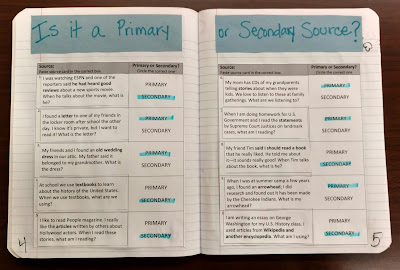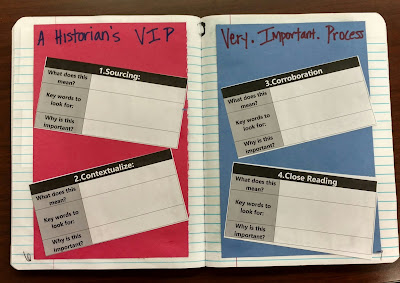Each school year I start with a new crop of 7th graders who I know are about to experience Social Studies in a completely different way. In my classroom...
- There is no textbook to lug around. We use one periodically, but rarely. I keep a class set in the room.
- Very few, if any, multiple choice questions. A lot more writing.
- Less and less "worksheets." A lot of collaboration with peers.
- More projects. Technology integrated into the subject.
- Every day vocabulary such as primary sources, contextualize, corroborate, bias, artifacts, inference.
- Questions that don't have one right answer. Having to defend their answers with evidence.
- And learning to "Think like historians."
This takes training. Students don't just come in knowing how to do this. I take a good amount of time at the beginning of the year introducing my students to the process of historical thinking. This is what I do...
Day 1:
Discussion about sources. Primary vs. Secondary sources. Sometimes there is a student who knows the difference, but they are in the vast minority. We explore the difference between primary and secondary sources and talk about what it means to infer.. We brainstorm the different types of primary sources. I have done this differently every year, usually by Googling "primary and secondary source lesson plans" and piecing together what works for me. This year, I came up with these which were mostly taken from this lesson plan.
These are recorded in a notebook that is my take on an interactive notebook. I call them HIT (Historians In Training) books. These books are used to collect information from a variety of sources and determine the accuracy of that information. (Click here for a post that goes into more detail on my HIT books).
Day 2:
Application of the discussion from day 1. I usually have a variety of stations (10-12) that have either scenarios or actual objects for students to travel to, in pairs, and decide if it is a primary or secondary source. The scenarios often come from the powers of Google. The process of students moving through stations is a teaching strategy that I use OFTEN. Such a great way to get kids up and moving, AND have them experience a variety of things in one class period.
This year I had 10 stations, each with a scenario card that they pasted into their HIT book and selected whether it was a primary or secondary source.
**The scenarios and base lesson plan I used for inspiration can be found here
Day 3:
Historical Thinking Day. Students learn some big words today. Sourcing. Contextualize. Corroboration. Close Reading. I am a huge fan of SHEG (Stanford History Education Group) and their website. They have so many awesome lesson plans for teachers to use. I am a frequent flier on their site!
I created these posters using PowerPoint, printed them off and laminated them together for the students to use. The information for these posters comes from SHEG and Gilder-Lehrman (another go-to website for social studies teachers!) Students are placed into 4 teams. Each group spends time with each term and students are required to fill out the charts about each word based on the information they discover. These charts are then cut out and pasted into their HIT notebooks. We have a brief whole-class discussion on the terms and I talk about how important it is to start with "sourcing."
And we move on to an exercise in sourcing. I call it "All Sources are not Created Equal." Again, the premise for this activity comes from SHEG. I took their idea and made a few changes. I create 6 different "Historical Questions" and then provide two types of sources. Students have to identify which sources are the most reliable based on the question. These are set up as different stations. Working in teams and rotating through stations, kids fill out these charts and paste them in the HIT notebooks.
**The point of today's lesson is to teach them that just because something is a primary source, it doesn't mean that it is truly accurate. By this point, my 7th graders think that a primary source is GOLD and cannot be wrong. This activity attempts to have them detect bias. I will have to refer back to this activity throughout the year. They LOVE primary sources!
Day 4:
Lunchroom Fight Part I and II
**Both of these are taken directly from SHEG** Click this link to create an account and access the lesson plan. (You'll be glad you did!) I made no changes to this one. The kids love it! BONUS...it may help provide a little empathy for the tough job Principals have when it comes to figuring out who to discipline when disputes happen!
Day 5-6ish (depending on the unforeseen variables that tend to "pop up" at the beginning of the year:
History in a Bag. This is without a doubt my FAVORITE lesson of the whole Historical Thinking Training that I do at the beginning of the year. I split this up into two different days. Usually PART 1 won't take an entire class period for me (75 minute classes), so I'll tack it on to the end of the previous one. You can read the entire lesson for PART 1 by clicking here.
Part 2 is really the one to get to. The shortened version is that I fill a tub with primary sources that all center around one person. Students analyze the artifacts and are able to determine who the person was, what he/she did for a living, where he/she lived, and some of his/her hobbies. Plus, there is a fun secret fact they figure out by the end of the day. The kiddos mention this each year as one of their favorites! Read the lesson for PART 2 here.
And there you have it. A new crop of 7th graders who have been trained in the art of historical thinking. They will spend the remainder of the year using the skills they learn in these first 5 to 6 days of my class.
**I do work in a middle school that uses a block schedule, so my class periods are about 75 minutes long. Each day can be split into two traditional 50 minute classes. There is definitely room for cross-over between days and time to add it technology "how-tos" that are necessary at the beginning of the year. Flexible is the way to be!**
Teachers reading this, or saving it to read for later, feel free to steal, borrow, copy, and use whatever you want. Don't hesitate to comment or contact me through Twitter (@JillWebs) if you have questions!












